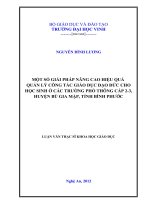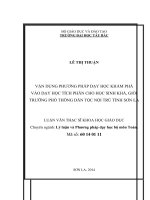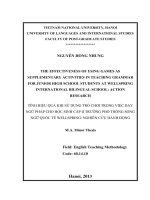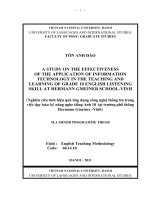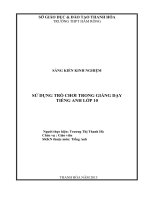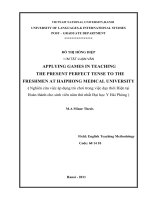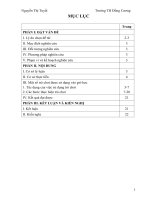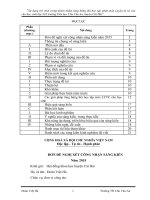Tính hiệu quả khi sử dụng trò chơi trong việc dạy ngữ pháp cho học sinh cấp II Trường Phổ thông Song ngữ Quốc tế Wellspring Nghiên cứu hành động
Bạn đang xem bản rút gọn của tài liệu. Xem và tải ngay bản đầy đủ của tài liệu tại đây (1.09 MB, 60 trang )
VIETNAM NATIONAL UNIVERSITY, HANOI
UNIVERSITY OF LANGUAGES AND INTERNATIONAL STUDIES
FACULTY OF POST-GRADUATE STUDIES
******************
NGUYỄN HỒNG NHUNG
THE EFFECTIVENESS OF USING GAMES AS
SUPPLEMENTARY ACTIVITIES IN TEACHING GRAMMAR
FOR JUNIOR HIGH SCHOOL STUDENTS AT WELLSPRING
INTERNATIONAL BILINGUAL SCHOOL: ACTION
RESEARCH
TÍNH HIỆU QUẢ KHI SỬ DỤNG TRỊ CHƠI TRONG VIỆC DẠY
NGỮ PHÁP CHO HỌC SINH CẤP II TRƢỜNG PHỔ THÔNG SONG
NGỮ QUỐC TẾ WELLSPRING: NGHIÊN CỨU HÀNH ĐỘNG
M.A. Minor Thesis
Field: English Teaching Methodology
Code: 60.14.10
Hanoi, 2013
VIETNAM NATIONAL UNIVERSITY, HANOI
UNIVERSITY OF LANGUAGES AND INTERNATIONAL STUDIES
FACULTY OF POST-GRADUATE STUDIES
******************
NGUYỄN HỒNG NHUNG
THE EFFECTIVENESS OF USING GAMES AS
SUPPLEMENTARY ACTIVITIES IN TEACHING GRAMMAR
FOR JUNIOR HIGH SCHOOL STUDENTS AT WELLSPRING
INTERNATIONAL BILINGUAL SCHOOL: ACTION
RESEARCH
TÍNH HIỆU QUẢ KHI SỬ DỤNG TRỊ CHƠI TRONG VIỆC DẠY
NGỮ PHÁP CHO HỌC SINH CẤP II TRƢỜNG PHỔ THÔNG SONG
NGỮ QUỐC TẾ WELLSPRING: NGHIÊN CỨU HÀNH ĐỘNG
M.A. Minor Thesis
Field: English Teaching Methodology
Code: 60.14.10
Supervisor: Dr. Ngơ Hữu Hồng
Hanoi, 2013
DECLARATION
-----------------------***-----------------------I hereby certify that this minor thesis entitled
THE EFFECTIVENESS OF USING GAMES AS SUPPLEMENTARY ACTIVITIES
IN TEACHING GRAMMAR FOR JUNIOR HIGH SCHOOL STUDENTS AT
WELLSPRING INTERNATIONAL BILINGUAL SCHOOL: ACTION RESEARCH
is completely the result of my own word for the Degree of Master at University of
Languages and International Studies, Vietnam National University, Hanoi and that
this thesis has not been submitted for any degree at any other university or
institution.
i
ACKNOWLEDGEMENTS
This thesis could not have been completed without the help, encouragement
and support of a great deal of people who all deserve my sincerest gratitude and
appreciation.
First and foremost, I wish to express my deepest gratitude to my supervisor,
Dr. Ngơ Hữu Hồng, for his training, guidance, and encouragement in the
preparation and writing of this minor thesis. This thesis would not have been
completed without his help from the period when this was in the commencing stage.
Secondly, I would like to send my thanks to my principal, who supported my
studies a lot by granting me days off to study and complete this minor thesis, even
during a busy time of the school. Many thanks are given to our friends and
colleagues for introducing and providing me with materials to carry out this study.
My special thanks also go to the students of class 789A3, Wellspring
International Bilingual School for their willingness to take part in my training
strategy scheme. Without their help, this study could not have been fulfilled.
I am also heavily indebted to my family – my parents and my brother. They
were always by my side to give me continual support and encouragement for all that
I did.
Furthermore, other big thanks from me to all others who directly or indirectly
supported me during the period I implemented this minor thesis.
Finally, I would like to send my special thanks to my readers for their
concern, interest and comments for this study.
Thank you.
Hanoi,
Nguyễn Hồng Nhung
ii
ABSTRACT
This study was conducted as action research in which students were taught
on how to process grammar deeply by applying games as supplementary activities
in English grammar teaching and learning. The study first aimed at enhancing junior
high school students’ motivation at Wellspring International Bilingual School to
study grammar and balance grammar learning with other skills learning (Speaking,
Listening, Reading, and Writing); and then, recognizing if using games as
supplementary activities increase students’ motivation in studying grammar. For the
accomplishments of these purposes, fifteen students in class 789A3 at Wellspring
International Bilingual School in Long Bien District, Hanoi, Vietnam were involved
in the study. The present study tends to use qualitative method with the support of
quantitative method. Then, the data instruments include pre-test, post-test and the
practitioner’s diaries. By comparing the results of the pre-test and the post-test, the
students’ increasing motivation in grammar studying could be revealed through the
improvement of the students’ grammar retention. Also, from the teacher’s diaries,
the enhancement of the students’ motivation in grammar studying could be
recognized through their involvement and participation in learning activities.
iii
LIST OF FIGURES AND TABLES
FIGURES
PAGE
Figure 1: Action Research cyclye (Sagor: 1992) ..................................................21
Figure 2: Data collection procedure ......................................................................24
Figure 3: The students’ results of the pre-test ...................................................... 28
Figure 4: The students’ results of the post-test .................................................... 30
Figure 5: The students’ results in the pre-test and the post-test ........................ 32
Figure 6: The students’ participant in learning activities in class...................... 34
TABLES
PAGE
Table 1: Schedule of Grammar Teaching for class 789A3 ..................................19
iv
TABLE OF CONTENTS
Declaration ...................................................................................................................i
Acknowledgement ...................................................................................................... ii
Abstract ..................................................................................................................... iii
Table of contents ........................................................................................................iv
List of figures ........................................................................................................... vii
INTRODUCTION .....................................................................................................1
1. Rationale for the study ............................................................................................ 1
2. Aims of the study ....................................................................................................3
3. Research questions ..................................................................................................3
4. Scope of the study ...................................................................................................3
5. Practical significance of the study ..........................................................................3
6. Methods of the study ............................................................................................... 4
6.1. Data collection methods ....................................................................................... 4
6.2. Data analysis ........................................................................................................4
7. Design of the study..................................................................................................4
DEVELOPMENT .....................................................................................................6
CHAPTER 1: LITERATURE REVIEW ................................................................ 6
1.1. Previous studies related to language teaching and learning.................................6
1.1.1. Studies related to using games in language teaching and learning ...................6
1.1.2. Studies related to using games in teaching grammar ........................................8
v
1.2. The importance of grammar ...............................................................................10
1.3. Which games should be used? ...........................................................................11
1.4. When should games be used ..............................................................................11
1.5. The importance of students’ motivation ............................................................ 13
CHAPTER 2: METHODOLOGY .........................................................................16
2.1. The background of the study ..............................................................................16
2.1.1. The study setting ............................................................................................. 16
2.1.2. Participants ......................................................................................................17
2.1.3. Materials ..........................................................................................................17
2.2. Hypotheses .........................................................................................................18
2.3. Implementation of the Action Research ............................................................. 19
2.4. Data collection instrument .................................................................................21
2.4.1. Pre-test and Post-test ....................................................................................... 21
2.4.2. Diaries .............................................................................................................21
2.5. Data collection procedure ..................................................................................22
Chapter 3: FINDINGS AND DISCUSSION ........................................................ 23
3.1. Data analysis preocedures ..................................................................................23
3.2. Research question 1............................................................................................ 24
3.2.1. Results from the pre-test .................................................................................25
3.2.2. Results from the post-test ................................................................................26
3.2.3. Comparison between results from the pre-test and the post-test .................... 28
3.3. Research question 2............................................................................................ 29
3.4. Summarization ...................................................................................................32
vi
3.4.1. Effectiveness of grammar games ....................................................................32
3.4.1.1. Effectiveness of grammar games in developing students’ motivation ........32
3.4.1.2. Effectiveness of grammar games in developing the ability of students’
understanding of the lesson ....................................................................................... 33
3.4.2. Difficulties when using grammar games in class............................................34
3.4.2.1. For the teacher .............................................................................................. 34
3.4.2.2. For students ..................................................................................................35
PART III: CONCLUSION ..................................................................................... 36
1. Recapitulation .......................................................................................................36
2. Limitations of the study ........................................................................................ 37
3. Suggestions for further study ................................................................................38
REFERENCES ...................................................................................................... viii
APPENDICES ........................................................................................................ xii
Appendix 1: Pre-test ................................................................................................. xii
Appendix 2: Post-test ............................................................................................. xvii
vii
INTRODUCTION
1. Rationale:
In studying languages in general and studying English in particular, it can be
said that grammar is seemed to be difficult and boring for students. It is thought by
students that English grammar contains complex, difficult, and different rules.
Besides, traditionally, many teachers approach grammar teaching very seriously,
making the lesson dull and uninteresting. Therefore, students usually feel tired and
boring in grammar lessons and then they are not motivated to study. However, as
one of language components, grammar is very necessary and nobody can refuse the
importance of learning this skill. According to William Somerset Maugham (The
Summing Up, 1938), “It is necessary to know grammar, and it is better to write
grammatically than not, but it is well to remember that grammar is common speech
formulated.” “Grammar is the structural foundation of our ability to express
ourselves. The more we are aware of how it works, the more we can monitor the
meaning and effectiveness of the way we and others use language. It can help foster
precision, detect ambiguity, and exploit the richness of expression available in
English.” Moreover, as stated by McKay (1987), in order to communicate
effectively in English, students need to have a good foundation in grammar. Once
again, Ur (1988) states that a person who knows grammar is one who can express
himself or herself in what would be considered as acceptable language forms. In
brief, although grammar plays an important part in English studying, students do
not have motivation in learning this skill.
What are the solutions to solve with the stated matter above? Perhaps,
teachers need to apply variable teaching methods to stimulate students to study so
that they can understand and master grammar as well as feel motivated when
studying lessons. There are many ways that help students be interested in and
follow the lessons. In the writer’s position, that games through lessons is one of the
most appropriate approaches. This approach can help students find studying English
grammar more easily. Thus, in the present study, the writer has an intention of
1
proving that applying games into lessons is also very effective for junior high
school students. Moreover, junior high school students are still at the age of young
students; therefore, they prefer do actions to sit quietly in class. As a result, the
writer thinks that games are appropriate for them to motivate their studying. She
also hopes that by using games, the students will not be bored and they will study
English grammar with full of motivation. Although learning grammar is not a
simple work, games encourage students to maintain their interest in learning. And
then, they can attain achievements in four communicative skills.
In this context, the students who took part in this research are rather good at
Speaking, Reading and Listening; however, they often have many difficulties in
Writing. They can communicate with native speakers very well but doing grammar
exercises is an obstacle for them. In fact, most of the students think that grammar is
the most boring lesson in English subject; studying grammar is just to repeat
structures, usages for these structures and vocabulary, and then, practice with
exercises. In other words, the students do not have motivation to study grammar.
Consequently, this also causes students’ failure to improve their communicative
skills. In order to solve the obstacle, the author carried out this Action research by
applying games as supplementary activities in teaching grammar in her own class.
The writer hopes that the new teaching method will bring the students a new
learning environment in which they can study with full of their interest, their
energy, and their stimulation.
In conclusion, with all of the reasons stated above, the researcher would like
to devote her time and effort researching to her thesis: “The effectiveness of using
games as supplementary activities in teaching grammar for junior high school
students at Wellspring International Bilingual School – Action research”. From
this, she expects to help her students motivate as well as make progress in studying
grammar.
2
2. Aims of the study:
The purpose of this research is to enhance junior high school students at Wellspring
International Bilingual School to study grammar, and then balance grammar
learning with other skills learning (Speaking, Listening, Reading, and Writing). The
paper aims to recognize if using games as supplementary activities increase the
students’ motivation in studying grammar.
3. Research questions:
This paper is designed to find out the answers to the following questions:
RQ1: How much does the use of games improve junior high school students‟
motivation in grammar learning at Wellspring International Bilingual School?
RQ2: If so, by what ways does this new teaching method enhance their motivation
in grammar learning?
4. Scope of the study:
As being shown in these research questions above, this study was conducted
at Wellspring International Bilingual School located in Hanoi. This was
implemented on fifteen students of class 789A3. Before the treatment of this action
research, they did not have motivation in grammar lessons and their results also
were not good. With the application of games as supplementary activities in
teaching grammar, the teacher – the researcher hoped to create attractive and
effective learning environment for her students so that they could feel motivated
and improve themselves.
5. Practical significance of the study:
This current action research tends to be institutional because it was carried
out with a small group of students in a specific context (only fifteen students in the
class 789A3 at Wellspring International Bilingual School). Thus, the researcher is
aware that the results cannot be easily generalized. She hoped that through the
results of this action research, she could help her own students increase their
motivation in studying grammar to improve their learning. And then, she herself
could improve her teaching skills.
3
6. Methods of the study:
The current action research tended to use qualitative method. Since only
fifteen students in class 789A3 joining in this study, the amount of students was
small and the researcher took notice of every member; therefore, the practitioner
employed qualitative approach with the support of quantitative method.
6.1. Data collection methods:
Data was collected by tests (pre-test and post-test) and the teacher’s diaries.
Firstly, the researcher identified the current learning situation or the students’
problems when dealing with grammar studying. Next, a system of tests including
pre-test and post-test was implemented to compare the students’ progress in
grammar retention. And then, during the treatment, the teacher’s diaries were
written weekly to collect the students’ motivation in grammar learning.
6.2. Data analysis methods:
The collected data was categorized to answer the two research questions.
Firstly, the results of the pre-test and the post-test were compared. From this, the
students’ motivation in grammar learning could be revealed through the
improvement of the students’ grammar retention. After that, all of the researcher’s
diaries during the treatment of fifteen weeks were collected. Then, she calculated
the number of participants in each week and demonstrated under the format of a
column chart. By this way, the enhancement of the students’ motivation in grammar
learning could be recognized.
7. Design of the study:
There are three main parts in the study:
Introduction: introduces Rationale, Aims of the study, Research Questions, Scope
of the study, Practical significance of the study, Methods of the study, and Design
of the study.
Development: includes three following chapters:
Chapter 1: Literature Review: introduces the theoretical foundations for
the whole study.
4
Chapter 2: Methodology: elaborates on the setting, the participants, the
materials, the methods used, the instruments, and the data collection
procedure.
Chapter 3: Findings and Discussions: introduces the data analysis
procedure, presents and analyses all the data to find out the answers to the
two research questions, and then gives out the summary from the findings.
Conclusion: summarizes all the major points in the study, reveals the limitations of
the study and proposes some suggestions for further studies.
5
DEVELOPMENT
CHAPTER 1
LITERATURE REVIEW
1.1. Previous studies related to language teaching and learning:
1.1.1. Studies related to using games in language teaching and learning:
Accepted by Wright, Betteridge and Buckby (1984), “Language learning is
hard work. Effort is required at every moment and be maintained over a long
period of time. Games help and encourage many learners to sustain their interest
and work.” Indeed, learning a new language requires continuous effort and
attempting. Thus, games create exciting and funny learning environment that can
help learners avoid being fed up with sometimes to maintain their inspiration to
continue studying. Sharing the same idea, Richard-Amato (1996: 10) acclaims that
games are effective for both teachers and learners. They help teachers “create
contexts in which the language is useful and meaningful”. They also “create
motivation, lower students' stress, and give language learners the opportunity for
real communication”. Undeniably, games assist both teachers and students to build
up real-life environment so that teachers easily lead students into lessons, and
students feel relaxing and simply take up new knowledge. However, together with
these advantages, games are often thought to be associated with fun and laughter so
that it is not really learning. Disagreeing with this conception, Kim (1995: 23)
asserts that learning a language together with enjoying oneself at the same time is a
possibility. Provided that we do not lose sight of the pedagogical values in foreign
language teaching and learning, studying through games can make pleasant
environment; and then, students will be motivated.
For young kids, Topkaya and Kỹỗỹk (2010) declare that primary school
curriculum for young learners’ English lessons should take more advantage of
games. Having the same idea with them, Sungurtekin, Sezer, Baỗeli-Kahraman
and Sadiolu (2009: p. 756) state that “by playing games, a child makes
6
acquaintance with his environment, learns life and gains new instructions.” In other
words, games are essential part of primary school education because the
contextualization and natural activities can make learning meaningful. Moreover,
from the result of the study “Effectiveness of Using Games in Teaching Grammar to
Young Learners” by Gülin Yolageldili and Arda Arikan (2011), it is declared that
“games are an important and necessary part of English language teaching and
learning in the context of primary schools‟ English lessons simply because they
provide EFL teachers with many instructional advantages. Games are one of the
best ways to direct young learners‟ energy into language learning because young
learners like to be physically active; moreover, they are imaginative and creative
and they learn subconsciously.” In reality, primary students are small students; they
do not have enough experience to understand knowledge terms or abstract
definitions. Instead of that, learning through pictures, images, or activities make
them comprehend simply. This finding also supports the present study since junior
high school students are still at the age of young students, their body develops quite
fast so that they would rather move and act than sit calmly. Therefore, games
motivate them to take part in learning activities; they can perform their imagination,
their creativity, and their energy to study subconsciously.
In teaching and learning vocabulary, games are also appreciated by many
teachers and researchers. Stated by Nguyen & Khuat (2003), games are used not
only for fun but also for helpful language practice and reinforce, and then, students’
communicative competence will be enhanced. Furthermore, when teachers want to
apply games into language lessons, they should consider the number of students,
proficiency level, cultural context, timing, learning topic, and the classroom
settings. In other research “The Effects of Using Games to Reinforce Vocabulary
Learning” carried out by Osha Saeed Al Neyadi (2007), the author also agrees that
using games and activities to practice vocabulary enhances students’ ability to
memorize words; encourages students’ interaction; and enhances students’
motivation. The author also suggests that teachers should take advantage of
7
vocabulary games and other activities to help students recycle words so that they
can utilize words naturally.
1.1.2. Studies related to using games in teaching grammar:
From the result of previous research, it can be realized that games are so
helpful in language teaching and learning, including teaching foreign language for
young learners or teaching vocabulary. Then, does it also have the same
effectiveness in teaching and learning grammar? This matter has also been studied
from different points by many scholars. Saricoban and Esen Metin (2000) wrote:
“Games and problem-solving activities... have a purpose beyond the production of
correct speech, and are examples of the most preferable communicative activities."
In addition, games have the advantage of allowing the students to "practice and
internalize vocabulary, grammar and structures extensively.” They can remember
the target grammar, structures, and vocabulary through repeated activities and drills
without being tired and boring since students often like studying and playing at the
same time rather than only sitting in one place and doing exercises. After that,
students will be absorbed in the grammar lessons unconsciously. Having the same
point of view, Bob Obee (1999: 6) affirms that language games promote students to
apply grammar knowledge into communicative situations.
In order to affirm the advantages of using games in teaching grammar,
Aydan Ersoz (2000) explains two reasons why games are effective for teaching
grammatical knowledge. Firstly, games that are amusing and challenging are highly
motivating. Secondly, games allow meaningful use of the language in context.
Thus, although learning a foreign language may be tiring and always needs
continuous effort, taking part in language games can help them avoid feeling dull
but feel enthusiastic and fascinated in language lessons. Moreover, according to
Saricoban and Metin (2000), "the use of such activities both increases the
cooperation and competition in the classroom." In other words, games are valuable
to create fun and passion in competition as well as associate the relationships among
students or between teachers and students.
8
In Vietnam, this matter has also been studied by many scholars. In the
research “How to teach Grammar communicatively” carried out by Nguyen (2005)
at Nong Lam University, the author suggested methods to teach students new
grammatical rules communicatively so that they can both learn and enjoy at the
same time. Especially, he stresses that games are an essential part of a teacher’s
resources. Games can motivate students’ energy into learning so that they can
remember the knowledge better. In other study of the application of games in
grammar review lessons for sixth grade accomplished by Luong (2009) (quoted in
Luu & Nguyen, 2010), he emphasizes that games really bring remarkable results in
students’ learning progress. They improve their ability in using grammatical
knowledge in both written tests and oral performance significantly. The topic of
application of games in teaching and learning grammar is also worked on other
participants. It is believed that English is an important subject in high school
because it assists students to prepare for basic knowledge in order that they can
continue their higher education or their future jobs. Thus, Nguyen (2010) (quoted in
Luu & Nguyen, 2010) does a research of “Teaching and learning Grammar through
games in the tenth grade at Hung Vuong high school”. From the results, the scholar
implied that games are necessary to reduce the difficulties of grammatical
knowledge as well as increase an exciting and comfortable atmosphere in teaching
and learning grammar.
As can be seen from many previous studies, this subject has been exploited
from different points of view; most of them focus on expressing difficulties and
suggesting solutions for teaching and learning grammar to Vietnamese learners. The
scholars mostly pay attention to the ways to create a relaxing and motivating
atmosphere so students will feel comfortable; and then, they carry out traditional
games in which teachers use handouts, pictures without the help of technology. In
other words, they have not referred to games which take advantage of technology
such as projectors, laptops, and slides. Moreover, the researchers have not pointed
9
out how to choose suitable games for the content of the lessons as well as students’
level and ages.
1.2. The importance of grammar:
It is quite reasonable to accept that grammar plays an important role in
learning English. Harmer (1987: 12) assumed that “Without some understanding of
Grammar, students would not be able to do anything more than utter separate items
of language for separate functions. The expression of functional language is only
possible through the use of the Grammar of the language” Apparently,
understanding grammar assists students to realize how the language works, how it is
written or how words are combined together, so students can grasp the proper
meaning without being confused with expression. Moreover, with an efficient
knowledge of grammar, students are easily promoted to use English more
accurately and fluently.
Secondly, according to Smith (2001: 15), if teachers neither help students
pay attention to grammar nor create opportunities for them to improve grammar,
learners are likely to have many difficulties in communication that require them to
take use of their existing grammar resources. Thus, without awareness of functional
grammar, it is not easy for learners to express their ideas and their thoughts.
Besides, they can get listeners be confused or comprehend in different point of
views. In other words, they can be not successful to transfer their information to
listeners.
In addition, Larsen – Freeman (1986:13) affirms that grammar is regarded as
a skill rather than an area of knowledge. It can be said that grammar is the fifth skill
besides four skills of reading, writing, speaking, and listening. Therefore,
developing skills take much time to practise and learning grammar also takes time.
In other words, grammar is the foundation for mastering four language skills; thus if
we get the basis of Grammar knowledge, we will find studying communicative
skills easy to advance.
10
In brief, grammar is acknowledged to be of importance in language in
general and in language teaching and learning in particular. When we realize and
understand a great deal of knowledge about Grammar, mastering four language
skills will be easier.
1.3 Which games should be used?
Unconsciously, games bring many advantages to language lessons; however,
choosing appropriate games takes consideration because games should create fun
environment without losing pedagogical values. Firstly, teachers should find out the
purpose of a game clearly. According to Nedomová (2007: 19), teachers “should
consider whether the game-like activity is for children only to make the lesson more
attractive and protect them from being bored or whether we tend to revise and
practise some particular part of grammar, vocabulary, etc.” Moreover, teachers
need to consider the level of the games before applying them into lessons. If the
game is suitable for students’ language level, they will feel happy and take part in
enthusiastically. However, if the game is too easy or too difficult, they will feel
boring and will not want to enjoy playing the game. In addition, it can be easily
realized that games help to enhance social interaction and participation from
students. Therefore, teachers should understand students’ favourites and if they can
learn best with games which require physical action interaction, competition and
participation. And then, teachers can use the games which can both maintain
pedagogical values and satisfy students. Furthermore, other factors such as the size
and the physical properties of the classroom, the equipment, materials and the time
available for a game (McCallum, 1980, p. xii) need paying attention to by teachers.
In conclusion, before choosing games to serve the lessons, teachers need take care
of some aspects stated above to make sure that the games are proper for the lessons
as well as for the students.
1.4 When should games be used?
Games are mostly thought to be used after studying all of the content of
lessons or at the end of the lessons to creature fun, or games are used when there is
11
not anything more to do in class. However, Lee (1979: 3) disagrees with this point
of view and states that “games should not be regarded as a marginal activity, filling
in odd moments when the teacher and class have nothing better to do.” In other
words, games should be carried out in the lessons and should not be considered as
sided activities. Thus, Rinvolucri (1990) claims that games can be used in any stage
of a lesson. Particularly, games can be implemented:
a) before presenting a given structure, especially to find out diagnostically how
much knowledge is already known by the learners;
b) after a grammar presentation to see how much the group have grasped;
c) as a revision of a grammar area
Moreover, choosing and applying appropriate games into specific situations
is also important. Unconsciously, finding a game that satisfies all of the needs of the
learners is quite difficult; thus, teachers’ preparation should be taken into
consideration. After that, when teachers implement games in lessons, they should
introduce its rules and give instructions to the learners directly and simply. Even
teachers may take advantage of using the mother tongue to give explanation since
when students understand what they need to do in the games, they can achieve
educational purpose in playing it. In addition, when games are playing, if students
make mistakes, teachers should not interrupt a game to correct the mistakes. Instead
of that, “interruptions should be as infrequent as possible so as not to detract from
the student‟s interest in the game. An alternative to immediate correction is to make
note of errors and discuss them when the game is over” (Celce-Murcia (1979: 54)).
In other words, interruptions may affect students’ attention and enthusiasm so that
teachers should wait until the game is over to discuss as well as correct their
mistakes.
It is also stated that games playing into pairs or groups interest both teachers
and students a lot because of their competition, cooperation and success. Pair work
or group work helps to improve students’ communicational skills as well as develop
solidarity among students. McCallum (1980: xii) suggests that teachers should keep
12
students in the same team during the year because it is beneficial for teachers to
save time and it is beneficial for learners to increase team spirit. In brief, games
which require students to work in pair and in group enable learners to expand their
language and communicational skills while building up competition and team spirit
among learners. Furthermore, thanks to games, students can develop their ability in
using language because games create real-life situations for students to participate
and practise. The importance is that teachers need to consider when or in which part
language games should be applied in lessons.
1.5. The importance of students’ motivation:
Since motivation is not only a vital but also a highly complex factor
determining more or less successful language learning, it is necessary to examine
approaches to motivation in learning in order to bring better insights into it. Over
the years, there have been a number of studies on motivation in foreign and second
language learning. In these studies, researchers have attempted to explain what is
meant by motivation.
Keller (1984) (quoted in Ellis, 1994) sees 'interest' as one of the major
components of motivation, defining it as “a positive response to a stimuli based on
existing cognitive structures in such a way that learners‟ curiosity is aroused and
sustained”. Accordingly, the excitement and inspiration is quite important to do
anything. Thanks to them, learners will be curious to find out new theory containing
in the subject, or they desire to study themselves without being bored or fed up with
any more.
Specifically, most of studies on motivation in foreign and second language
learning have been influenced by the work of Gardner (1985) (quoted in Spolsky,
1998), who defines motivation as consisting of effort, plus desire to achieve the goal
of learning, plus favourable attitude towards learning the language. In this present
study, the researcher also took notice of the matters referred to students’ motivation
as mentioned in this conception of Gardner to help them enhance to study grammar.
In view of that, when learners express their positive and enthusiastic attitude, they
13
spend more time studying, and look forward to lessons, they get motivated in
learning.
Sharing the sample point of view with Gardner (1985), another theory on
motivation can be seen from Littlewood’s perspective (1998:53) that “in second
language learning as in every other field of human learning, motivation is the
crucial force which determines whether a learner embarks on a task at all, how
much energy he devotes to it, and how long he perseveres. It is a complex
phenomenon and includes many components: the individual‟s drive, need for
achievement and success, curiosity, desire for stimulation and new experience, and
so on”. Apparently, according to Littlewood, not only highlighting the important
role of motivation in second language learning but also emphasizing the „highly
complex construct‟ of motivation claimed that if a learner is motivated, he/ she will
probably decide to undertake a particular task with certain amount of energy and
time needed for it.
Furthermore, McKay and Tom (1992:2) point out that the need and drive to
communicate with others in a new language provide strong motivation for most
learners. Accordingly, when learners have a specific purpose, in the context, the aim
to communicate in a foreign language, there exists the stimulation inside them to
force them to study to fulfill their objective. When applying this theory into this
present research, the teacher believes that this theory is also benefit. Since when
they speak in a new language, together with the number of vocabulary, grasping
functional grammar is also affective in the support of transferring information to
addressees.
This is more or less similar to the opinion of McKay and Tom, Lightbown
and Spada’s (1999: 56) state the definition of motivation in second language
learning that “motivation in second language learning is a complex phenomenon
which can be defined in terms of two factors: learner‟s communicative needs and
their attitudes towards the second community”. They also add that ''if learners need
to speak the second language in a wide range of social situations or to fulfill
14
professional ambitions, they will perceive the communicative value of the second
language and will therefore be motivated to acquire proficiency in it. Likewise, if
learners have favourable attitudes towards the speakers of the language, they will
desire more contact with them.”
Learners’ motivation can change overtime and effect on their language
learning. Various studies have found out that motivation is strongly related to
success in language learning. Particularly, Gardner (1985) (quoted in Spolsky,
1998) sums up “… it seems clear that achievement in a second language learning is
influenced by attitudinal/motivational characteristics. Postulating that achievement
in a second language learning is promoted by an integrative motive is not
tantamount to saying that this is the only cause or predictor”.
However, many research findings shows that motivation makes learning
successful, and the relationship between learning achievement and motivation is an
interactive one. As Gardner and Smythe (1981) (quoted in Hedge, 2000) claim that
the high correlation between motivation and successful learning confirms the
crucial importance of motivation in the classroom whether learners arrive with it or
whether they acquire it through classroom experience.
15
CHAPTER 2
METHODOLOGY
2.1. The background of the study:
2.1.1. The study setting:
The study was conducted at Junior High school system of Wellspring
International Bilingual School located in Hanoi. At the school, the program of
English subject is different from public schools. There are fourteen periods per
week to study subjects in English program, including eight periods of ESL (English
as a Second Language), two periods of Mathematics, two periods of Biology, and
two periods of ICT (Information Communications Technology). In this present
research, the writer only paid attention to ESL subject. With eight periods of ESL
each week, there are six periods that students study with the native speaker and
there are two periods that they study with the Vietnamese teacher, the present
researcher. The native speaker is in charge of teaching students language skills such
as Listening, Speaking, Reading, Writing, and introducing Cultures in Western
countries. The Vietnamese teacher is in charge of teaching the students Grammar,
Vocabulary, and Structures. According to the International program of Junior High
school system, students follow three course books basing on their levels. These
course books include Solution Elementary, Solution Pre-Intermediate, and Solution
Intermediate. In fact, the students taking part in this study were in pre-intermediate
level; therefore, they studied the course book of Solution Pre-Intermediate.
In term of the course schedule, it took learners thirty periods (fifteen weeks)
to finish the last half of the course book during the second semester. Each week, the
students studied two periods of grammar. Each period lasts for forty-five minutes.
As a result, the students spent ninety minutes studying grammar lesson every week.
For each lesson, the teacher helped her students understand one grammar part
according to the course distribution.
The study room was a large room (about thirty square meters) which was
equipped with modern facilities such as a teacher’s table, students’ desks, two white
16
